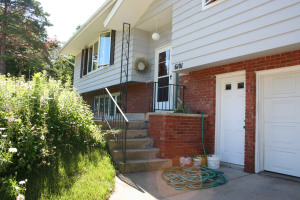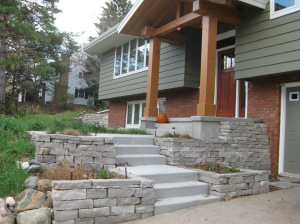Landscape architects, remodelers team up to ensure the outside is as beautiful as the inside
Often when a client decides to take on a major home remodeling project that includes an addition or some reconstruction of a home’s façade, they plan and budget for the home remodel, but neglect updating the landscaping at the same time. The result is a beautifully remodeled home with a yard that is lacking.
“Sometimes people just start thinking with the inside and don’t see the connection with the outside,” says John Gishnock III, landscape architect and ecological designer with Formecology, a landscape design/build and care firm based in Evansville, Wis.
If a client takes a holistic approach to the remodeling project, the landscape can end up as beautiful as the home renovation and enhance it.

Formecology helped breathe new life into a beloved home by transforming the uninviting, outdated entryway into a beautiful, welcoming, functional space. This project provided an excellent opportunity to work collaboratively with Associated Housewrights, whose architectural modifications harmonized perfectly with the landscape design, resulting in a complete transformation of the front facade and entryway.
“A lot of people think they can do the landscaping themselves, and they don’t see the value in having a professional really create a plan,” says Chad Speight, president of Chad’s Carpentry in Madison, Wis. “Of course they see the value when designing and planning for an alteration to their home, but they don’t often realize how important the yard can be to completing that exterior façade.”
Though remodelers and landscape architects tend to not work simultaneously on projects—typically the home renovation is phase one of a project and improving the landscape is phase two—bringing both parties together at the onset helps provide cost savings and adds value to the design and the project’s outcome.
The fact is projects can disrupt the landscape. Contractors often use areas of a client’s lawn to complete the project. They designate an area for materials that get delivered and establish a staging area, which can damage the existing lawn. The process of building an addition to a home, or completing a major exterior upgrade to a home, such as adding extra inches of foam to the exterior and then re-siding it to increase energy efficiency, also damages the existing landscape. Even fixing grading problems with the house to decrease the amount of water near the foundation and in the basement requires major excavation to the yard.

Locally sourced natural stone was used to create aesthetically appealing retaining walls and planting beds, which were filled with hardy native wildflowers and grasses for a beautiful and eco-friendly look. The new entryway allows for a more leisurely and naturalistic approach to the home. Two ornamental trees were used to visually anchor the sides of the house, while a texturally rich cobblestone dripline and small bioswale improve the flow of water on the site.
“These types of projects will need us to recommend a landscape architect and if a client is open to that, to collaborate with that professional in planning and budgeting for the project,” Speight says.
There are benefits to having the landscape architect and remodeler work together on a project. They can enhance a home’s outdoor living area by solving grade and elevation issues between indoor and outdoor spaces. They can ensure continuity between materials selected for the interior and exterior remodels. By communicating with the builder, the landscape architect can also strategically place planting beds and vegetation in areas around the home to enhance the structure, not hide it.
Having the landscape architect in the process during the planning stage also lets the client properly budget for that second phase of work.
“Landscaping is sometimes harder for a potential client to put a price tag on than a remodeling project,” Gishnock says. “It can happen a lot where we’re left with smaller budgets than necessary, but if you’re sitting down with a [landscape architect and a] remodeler at the same time, you’re able to speak to those costs related to the exterior and budget for them early on.”
If a landscape architect is brought in at the onset, the remodeler can provide him or her with the renovation plans so the landscape architect can design with the new build in mind and better integrate the plantings and outdoor spaces with the house.
“With a plan you minimize wasted time, wasted money, wasted energy by doing things you may later undo,” Gishnock says. “There’s always more you can bring to a project if you plan first—not more in terms of cost, but more in terms of value, opportunity and more beauty with planning.”
This type of communication through the design of the renovation promotes better planning for the overall project. A landscape architect can better enhance the views a client will have out of their windows, placement of trees for shading, paths and outdoor living spaces so there’s a connection between the home and the yard through the landscape design.
“We provide all of that information to the landscape architect and generally have a few conversations about priorities, about placement of doors and windows and siding and all those things we’re thinking about as the designer of the building,” Speight says. “This ensures the landscaping, and in particular, the long-term shading provided by trees and all that, is being thought out.”
Working simultaneously with a landscape architect and a design/build firm can also help integrate the client’s vision for their indoor space with their outdoor space. Gishnock believes that established relationships between landscape architects and remodeling contractors also improves the communication between the two parties, allowing for a better dialogue between both to minimize mistakes and optimize the space.
John’s Four Goals
When landscape architect and ecological designer John Gishnock III works on a landscaping project he aims to complete the following:
1) Integrate indoors and out
2) Identify/preserve site amenities
3) Identify opportunities for savings
4) Clear communication means better results
Sometimes contractors even can combine some tasks such as grading, excavating, earth moving and hauling, which saves the client money. Proper planning between the two parties can even preserve existing landscape such as oak trees or free-standing structures.
Gishnock adds that landscape architects also can strengthen a building’s redesign by improving circulation and safety and using complementary materials where the building and landscape interface. Complementing the architectural style of a home with the landscape also enhances curb appeal and can increase the home’s resale value.
“There’s always so much opportunity there to make a safe, functional and casual connection between the immediate outdoor space and that indoor space,” Gishnock says. “You couldn’t give the client everything they wanted if you weren’t working with the outdoor people to fill that need outside the house proper.”—Amalia Deligiannis
| 3/18/2014 12:00:00 AM |
0 comments